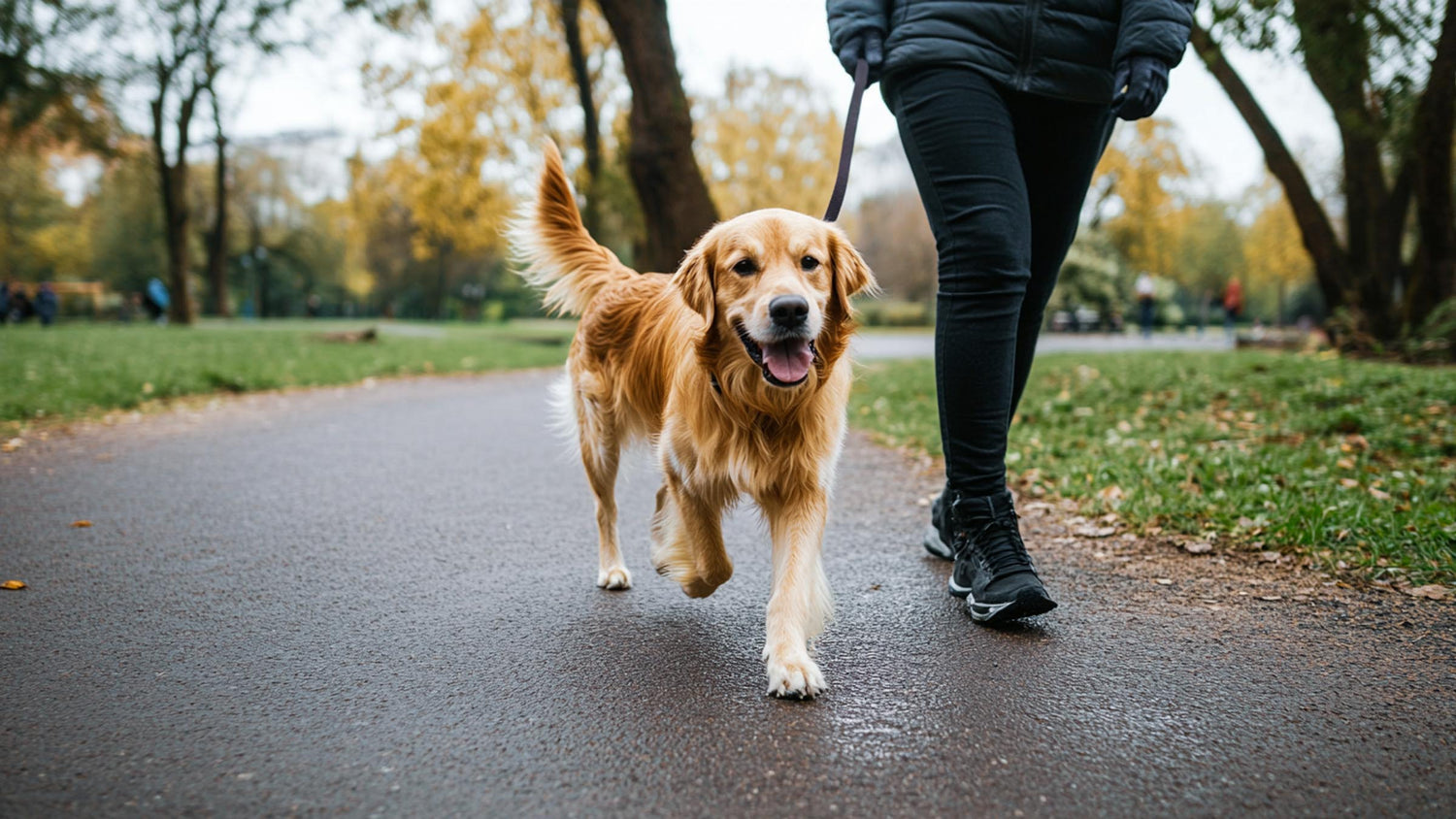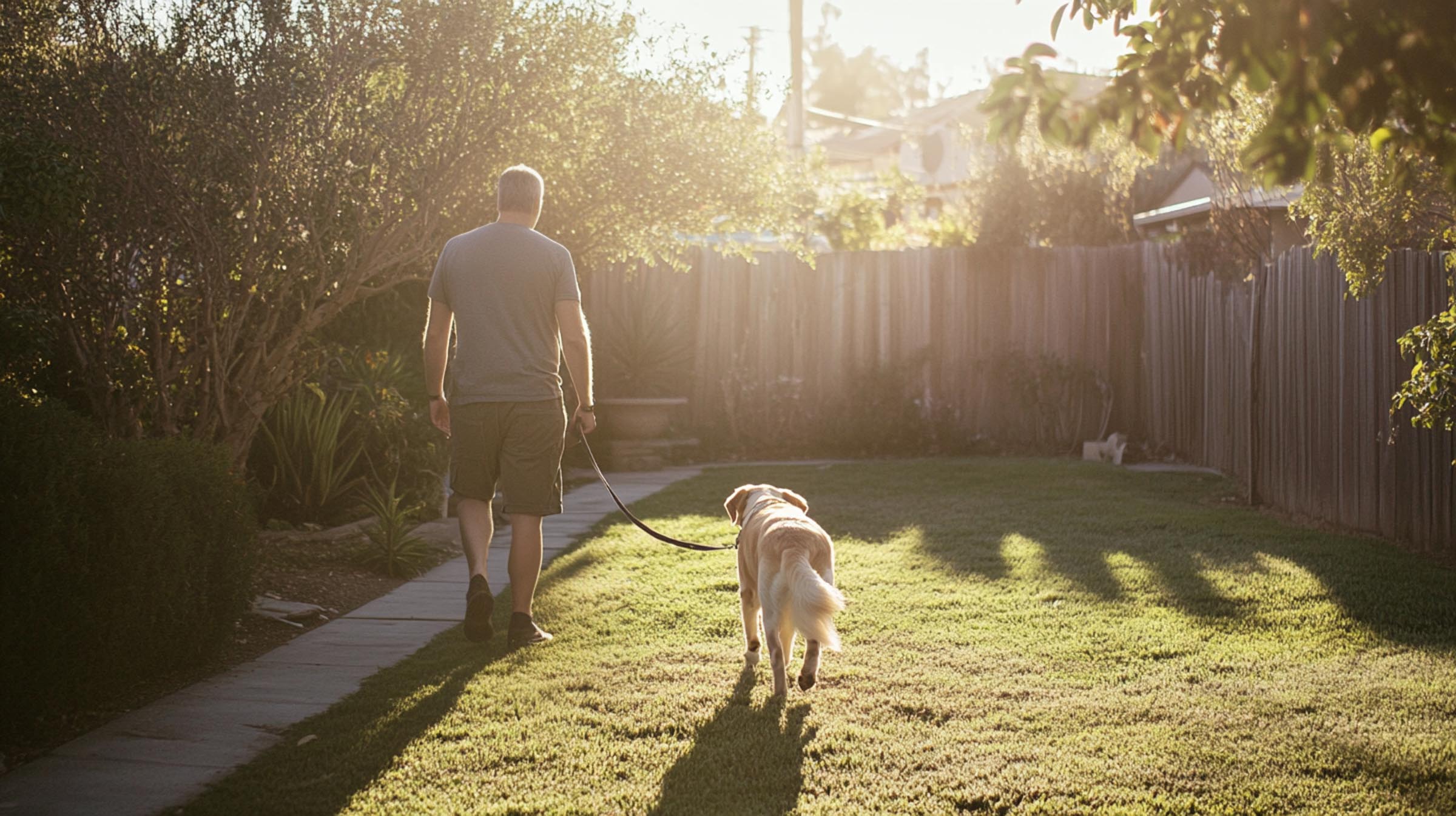Leash training is a crucial skill for every dog, ensuring safe, enjoyable walks while preventing behavioural issues like pulling and reactivity. Whether you’re working with a puppy or retraining an older dog, the right methods will transform your walks. This guide offers expert advice on leash training, covering basic principles and advanced techniques for managing distractions and reactivity.
Summary
- Start leash training in low-distraction environments and gradually increase difficulty as your dog improves.
- Use high-value treats to reinforce desired behaviour and gradually phase out treat reliance.
- Manage pulling with techniques like stopping, directional changes, and appropriate reinforcement.
- Introduce structured and relaxed walking patterns to maintain a balance between control and freedom.
- Some dogs may require professional guidance for managing reactivity or severe leash-related issues.
- Leash training can take time and present challenges—staying motivated is crucial for success. Celebrate small wins, end sessions positively, and remember that progress is a journey.
Why Leash Training is Critical for Every Dog

Leash training is about more than just preventing pulling. It’s a critical part of ensuring your dog’s safety, especially in public spaces, and teaching them how to behave in stimulating environments. Proper leash training fosters better communication between you and your dog, strengthening your bond and ensuring more relaxed, enjoyable walks.
Important: If your dog shows extreme leash reactivity (e.g., aggressive behaviour when seeing other dogs or people), this may go beyond standard leash training. In such cases, a certified professional dog trainer should be consulted, as reactivity can stem from genetics or deeper behavioural issues.
Benefits of Leash Training
- Safety: Protects your dog and others when walking in busy public areas.
- Stress-free walks: Prevents pulling and erratic behaviour, allowing you to focus on enjoying the walk.
- Improved behaviour: Trains impulse control, resulting in calmer behaviour in stimulating environments.
- Bonding: Establishes better communication between you and your dog.
Essential Equipment for Leash Training
The equipment you choose will play a crucial role in the success of leash training. While some tools work well for certain dogs, others may hinder progress. Here’s what you need to know:
Harnesses
Harnesses, especially front-clip ones, are excellent for many dogs as they help redirect pulling. However, they aren’t a one-size-fits-all solution. Some dogs may continue pulling despite wearing a harness, often because harnesses give them more leverage to use their full body strength, which can allow for more forceful pulling if not managed properly.
Harness Types:
- Front-clip harness: Effective for many dogs, as it redirects pulling.
- Back-clip harness: More comfortable but may encourage pulling.
If your dog pulls excessively even with a harness, consider switching to other tools like head halters or training collars.
Training Collars and Halters
For dogs who pull relentlessly, training collars or head halters can provide better control. Training collars, such as martingale collars, offer limited tightening, while head halters control the dog’s head and reduce their ability to pull.
Caution: These tools should be used with caution and under the guidance of a professional to avoid causing discomfort or injury to the dog. It’s essential to avoid aversive techniques, as improper use can lead to anxiety or aggression.
Leashes
For regular walks, stick to a standard 1.2-1.8m leash (4-6 feet) for optimal control. Avoid retractable leads for leash training, as they often maintain constant tension and reduce your ability to redirect and manage your dog’s behaviour.
Start in Low-Distraction Environments

The key to successful leash training is starting in low-distraction areas where your dog can focus on learning without being overwhelmed. This helps your dog grasp the fundamentals before tackling busier or more stimulating environments. Whether you're working with a puppy or an older dog, it's essential to build their confidence and understanding of leash behaviour in these calmer settings.
Indoor Training for Focus
Begin leash training in your home or a quiet backyard. Let your dog wear their harness and leash while associating it with positive experiences like treats or play. Gradually introduce short walks indoors, rewarding your dog for maintaining a loose leash. This creates a strong foundation of trust and familiarity with leash walking before adding more distractions.
Gradually Introduce New Environments
Once your dog is walking well indoors, move to controlled outdoor spaces like your backyard or a quiet park. Slowly increase the number of steps between rewards, teaching your dog that staying close and walking calmly results in treats. This method reinforces good walking habits in progressively more challenging environments.
Leash Skills Before the Walk
Start your leash training before leaving the house. Practise calm behaviour while attaching the leash and even at the door to set the tone before entering the busier street.
Leash Training in Difficult Environments

For dog owners living in busy areas or neighbourhoods filled with distractions, finding low-distraction environments may not be practical. If you're training in these more stimulating areas, try these strategies:
- Early or Late Walks: Aim to train your dog during quieter times of the day when fewer distractions are present. Early morning or late evening walks often provide calmer environments for leash training.
- Find Side Streets or Alleyways: If you live in a crowded city, look for quieter side streets or alleyways to practise. These spaces usually have fewer distractions and give you more room to stop or turn as needed.
- Drive to a Quieter Spot: If possible, drive your dog to a nearby park or open area that is less crowded, at least for initial training sessions. Gradually reintroduce them to busier streets.
- Short Sessions in Stimulating Areas: If you must train in a busy area, keep the sessions short. Spend 5-10 minutes practising focus exercises before increasing the length of your walks.
- Use Long Leashes in Safe, Open Spaces: If you have access to a safe space like a park, using a longer leash can give your dog more freedom to sniff and explore while you practise loose-leash walking from a distance.
- Work on Impulse Control at Home: Focus on impulse control games (such as waiting for a release cue) in the home or backyard before tackling crowded sidewalks. Once your dog understands how to wait patiently, you can apply this skill to busier environments.
Teaching Loose-Leash Walking

Loose-leash walking is a fundamental skill where the dog walks beside you without pulling, with the leash forming a relaxed "J" shape.
Control Without a Formal Command
While a formal “heel” command can be very useful across various situations, it's not necessary when teaching your dog to walk calmly by your side. You simply want your dog to stay close to you without pulling.
Managing Pulling
Managing pulling can be challenging, especially in busy areas. Here are effective ways to curb pulling without disrupting the flow of your walk:
Stop-and-Wait Technique
If your dog pulls, stop walking immediately. This teaches them that pulling results in a stop in forward movement.
Wait for them to return to your side, and only then resume walking. If they won’t walk back to your side:
- Walk backward slightly to encourage them to return to you.
- Wait for a moment, then call them back and reward when they return to a loose-leash position.
Circling Technique
When your dog pulls, guide them in a small circle around you to refocus their attention. In tight areas, circling may not be feasible, so instead try using the change of direction technique.
Change Directions
If your dog pulls, turn them 90 degrees or 180 degrees to redirect their focus. In narrow or busier spaces, you can turn your dog around using a gentle leash guide, then resume walking.
Tip: In high-traffic areas where stopping or turning can be difficult, such as crowded sidewalks, practise these techniques proactively when you have the space to do so, rather than waiting for your dog to pull and then finding you do not have the space to redirect them. Additionally, simply avoid high traffic environments until you can successfully walk without frequent pulling.
Building Focus for Better Walks

Maintaining your dog’s attention is critical to leash training. Focus exercises can reduce distractions and help prevent pulling or lunging at triggers like other dogs or people.
“Watch Me” Command
Teaching your dog to make regular eye contact during walks helps maintain their focus on you rather than their surroundings. Start by practising the “watch me” command at home, and reward them every time they make eye contact. Gradually introduce this during outdoor walks, reinforcing it consistently.
Focus Games
Use games to keep your dog’s attention on you. For instance, stop randomly during walks and wait for your dog to check in by looking at you. Reward them immediately when they do. This reinforces the idea that checking in with you is beneficial.
Tip: These focus games are most effective if practised in low-distraction environments before being applied in busier areas.
Transitioning from Quiet to Busy Environments
Once your dog has mastered loose-leash walking in a quiet setting, it’s important to gradually transition to more stimulating environments without overwhelming them.
- Gradual Exposure: Move to slightly more distracting environments, such as a neighbourhood park or a quiet street, before tackling busy sidewalks or dog parks. This progression helps your dog adjust at a manageable pace.
- Increase Distraction Levels Slowly: Start with mild distractions, like passing cars or a single jogger, and reward your dog for calm behaviour. Slowly increase the intensity of the distractions as your dog remains focused on you.
- Practise Short Walks in Busy Areas: Rather than going for long walks in a busy environment, do short 5-10 minute training sessions. This allows your dog to practise focus and leash manners in a stimulating area without becoming overwhelmed.
This step-by-step progression helps your dog handle increasingly complex environments with confidence.
Handling Over-Excitement and Leash Biting

Managing Leash Biting
Some dogs, especially puppies, might bite or mouth the leash out of excitement. If this happens, stop walking immediately and wait for them to stop biting. Once they calm down, reward them for walking calmly and continue. However, if your dog is biting aggressively due to a trigger (such as another dog or a loud noise), stopping alone may not work. In these cases, redirect their focus, increase distance from the trigger, or consider working with a professional trainer if the behaviour escalates.
Pre-Walk Play to Reduce Over-Excitement
For dogs that are highly excitable, engaging them in a pre-walk game (such as tug or fetch) can help burn off some excess energy, making them more manageable during the walk. Additionally, providing mental stimulation, like puzzle games or short obedience sessions, helps reduce excitement levels.
Gradually Reducing Treat Dependence

Once your dog is consistently walking on a loose leash, it’s important to reduce their dependence on treats to ensure they can walk calmly without expecting a constant reward.
Phasing Out Treats
Begin by rewarding every few steps, and gradually increase the distance between rewards. Eventually, move to using verbal praise, petting, or allowing your dog to sniff as a reward. The key is to make sure your dog knows that walking calmly is still rewarded, even if it’s not always with food.
Alternatives to Treat-Based Training
While treats are often a powerful tool for reinforcing positive behaviour, they may not work for every dog, especially in highly stimulating environments or with dogs that aren't food-motivated. Here are alternative forms of reinforcement:
- Play-Based Rewards: Use short bursts of play (such as tug or fetch) as a reward during walks. This can help engage dogs that thrive on physical activity and interaction.
- Verbal Praise and Affection: Some dogs respond better to verbal praise and physical affection than treats. Be enthusiastic and consistent with your praise to reinforce good behaviour.
- Environmental Rewards: Allow your dog to sniff or explore as a reward. This taps into their natural curiosity and provides mental stimulation without relying on food.
Using a mix of these rewards can help keep your dog engaged and reduce the reliance on treats over time.
Advanced Techniques for Managing Reactivity
Reactivity on the leash—whether it’s directed toward other dogs, cars, or people—can be one of the most challenging issues to address during walks. Here are some expert strategies to manage reactivity.
Distance and Desensitisation
If your dog becomes reactive to specific stimuli, start by increasing the distance between your dog and the trigger. Gradually reduce the distance as they become more comfortable, rewarding them for calm behaviour. This approach, known as desensitisation, helps your dog build positive associations with previously stressful situations.
Counter-Conditioning and Clicker Training
Counter-conditioning involves changing your dog’s emotional response to a trigger. For example, if your dog reacts aggressively toward other dogs, pair the sight of other dogs with high-value treats before they react. Over time, this helps your dog associate the trigger with positive outcomes.
Using a clicker or a verbal marker like “yes” helps reinforce calm behaviour during reactivity training. Timing is essential—mark the exact moment your dog exhibits calm behaviour near a trigger, then reward immediately.
Staying Motivated

Leash training isn’t just about teaching your dog—it’s also a process that requires patience and persistence from you. While training your dog to walk calmly on a leash can be frustrating at times, staying motivated is key to long-term success.
The Challenges of Leash Training
Leash training can take time, and the pace at which dogs learn varies. Some dogs will pick up on loose-leash walking quickly, while others may take weeks or months to consistently walk without pulling or getting distracted. Here’s what you can expect:
- Puppies: Typically begin showing improvement within 2-4 weeks with regular training sessions.
- Older dogs: May take 1-3 months, especially if they have developed bad habits like pulling.
- Reactive dogs: Training could take 3 months or more, especially if addressing fear or aggression requires professional intervention.
Common challenges include:
- Inconsistent progress: Your dog might behave perfectly in quiet areas but struggle in busy environments.
- Reactivity: Some dogs may react to other animals, people, or distractions, requiring extra effort to manage their focus.
- Excitement: Highly energetic dogs can make progress slow, as they are often more easily distracted or prone to pulling.
It’s important to remember that every dog learns at their own pace, and setbacks are a normal part of the training process.
Rewards for the Owner
One of the biggest hurdles in leash training is maintaining your own motivation. Dogs don’t reflect on their efforts across an entire walk, but you do—and it’s easy to feel frustrated if things aren’t going smoothly. Ending each session on a positive note can help you stay motivated and focused.
- End the session positively: Even if the whole walk hasn’t gone perfectly, offering a final treat or praise for good behaviour can help you feel that the session was a success.
- Celebrate small wins: Each small improvement—whether it’s walking a few extra steps without pulling or remaining calm near a distraction—is progress worth celebrating. Acknowledge these moments as successes.
- Keep perspective: Remember that leash training is a process. Every time you and your dog practice, you’re laying the foundation for better walks in the future. By maintaining a long-term perspective, you can reduce frustration and stay committed.
Leash Training is a Journey, Not a Sprint
The key to successful leash training is patience—both with your dog and with yourself. Some dogs may take longer to learn, especially in high-distraction environments, but every step you take together is progress. Staying motivated and maintaining a positive attitude throughout the process will not only make the training more effective but also strengthen the bond between you and your dog.
Conclusion
Leash training takes time and patience, and the pace of progress can vary greatly between dogs. It’s important to be patient and consistent. From mastering the basics of loose-leash walking to managing reactivity in more challenging environments, the key is to adapt your techniques to your dog’s specific needs. By reinforcing positive behaviour and addressing challenges with the right tools and methods, you’ll create a stress-free walking experience for both you and your dog.




Leave a comment
This site is protected by hCaptcha and the hCaptcha Privacy Policy and Terms of Service apply.